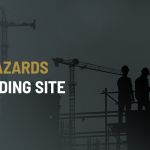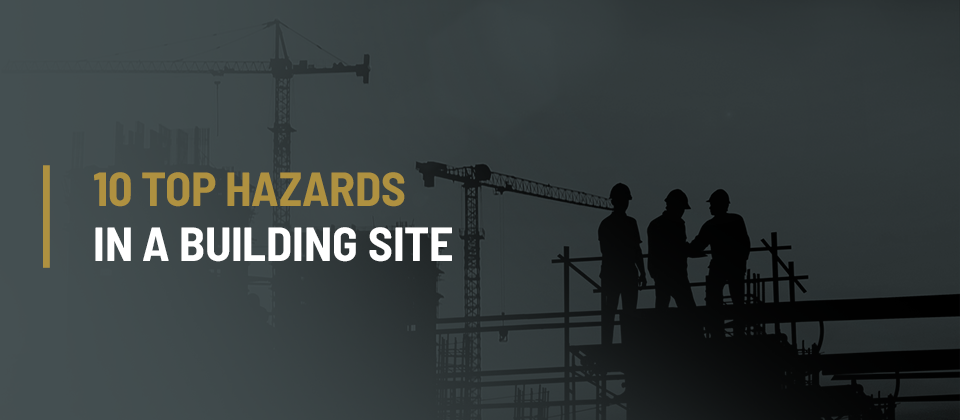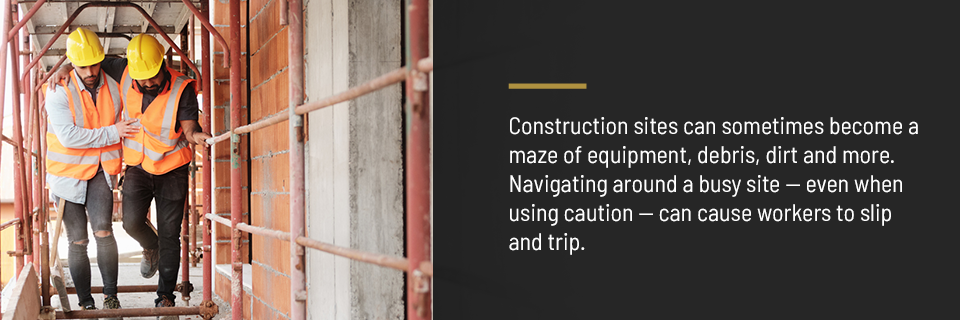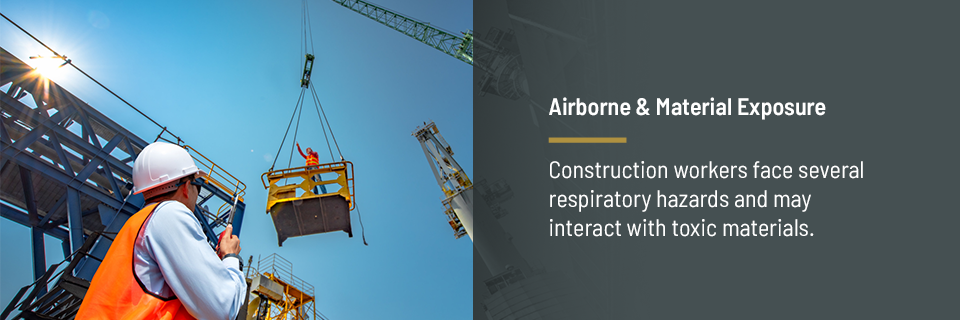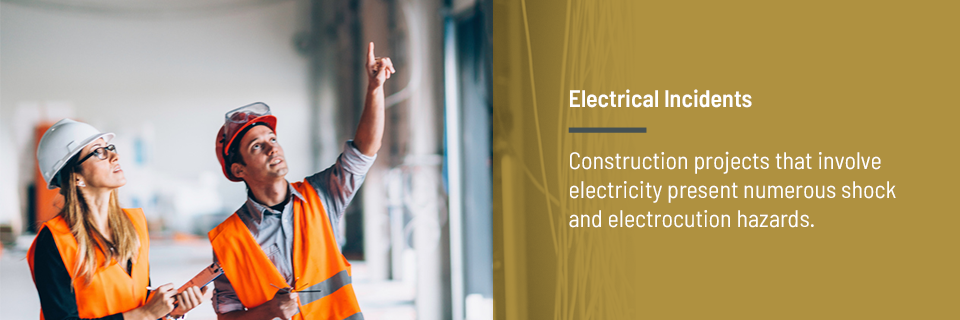Nearly 6.5 million people go to work at approximately 252,000 construction sites across the U.S. each day. On the job, these construction workers face a wide range of occupational safety hazards. Their heavy equipment and job site conditions can create dangerous situations that require careful navigation.
According to the Occupational Safety and Health Administration (OSHA), the fatal injury rate for the construction industry is higher than the national average for all other industries. OSHA implements standards to help protect construction workers and keep working conditions safe. But, under severe and undesirable work circumstances, accidents happen.
Top Hazards in Construction Sites
Though construction site rules and regulations seek to minimize risks, human error and machine failure still present hazards. The following are some of the most common risks on a construction site.
1. Falling
OSHA cites that falls account for the greatest number of fatalities in the construction industry each year. These falls may occur due to unstable work surfaces, the misuse or failure to use fall protection equipment and human error. Though falls can happen in a variety of situations, many occur when workers are using ladders.
Ladder falls account for approximately 24,882 injuries and 36 fatalities yearly in the construction industry. Falls from construction ladders may occur when:
The wrong type of ladder is used for a task.
Workers are improperly trained on ladder safety.
A ladder is structurally damaged, including broken or missing rungs, steps or cleats, split or bent side rails and missing or damaged safety devices.
A ladder is used beyond its maximum intended load.
A metallic ladder is used for electrical work or near power lines.
Rung contaminants cause ladder slips that lead to a loss of balance.
Following OSHA standards, manufacturer guidelines and performing regular inspections can help prevent ladder falls. In the flow of the workday, mistakes or fatigue may lead to improper usage and an increased risk of injury.
2. Slipping and Tripping
Construction sites can sometimes become a maze of equipment, debris, dirt and more. Navigating around a busy site — even when using caution — can cause workers to slip and trip.
According to OSHA, a slip occurs when a construction worker loses their balance after a loss of friction or traction between the worker’s foot and the work surface. Trips are slightly different, as they occur when a construction worker’s foot or lower leg hits an object, which causes them to lose their balance.
There are a variety of substances and items that may cause a slip or trip on a construction site, including:
- Water
- Mud
- Grease
- Oil
- Dust
- Powders
- Plastic wrapping
- Sloped walking surfaces
- Gravel
- Plant debris
- Hoses
- Cables
- Wires
- Cords
- Clutter or debris
- Gaps in a walking surface
OSHA reports that many slips and trips occur in stairways. This can happen under the following circumstances:
- Stairway treads are filled with dangerous objects, debris or materials.
- A stairway is slippery and is not cleaned quickly.
- A stairway’s treads do not cover the entire step and landing.
- A stairway with four or more risers that extends higher than 30 inches does not have handrails.
Slips and trips often cause minor injuries such as strains, sprains, contusions, bruises, abrasions, lacerations and fractures. Common injury sites for a slip or trip injury include a worker’s foot, ankle, knee, back, hip, shoulder, wrist, elbow or head.
Construction workers may be trained on how to avoid slips and trips and comply with OSHA standards, but this does not completely remove the risk. If a worker is tired or distracted, or if the weather conditions obstruct their vision, the risk of a slip or trip may be increased.
3. Airborne and Material Exposure
Construction workers face several respiratory hazards and may interact with toxic materials. Some of these dangerous materials include:
- Lead: Construction workers may absorb lead when inhaling lead-contaminated dust, fumes or mist. Lead may be present in roofs, cornices, tank linings, paint or electrical conduits. Though lead paint has been banned from residential use, it is still used to prevent rust and corrosion on bridges, railways, ships, lighthouses and other steel structures. Workers who take part in demolition, renovation, installation or other activities where lead is present may be at risk for lead exposure. Repeated lead exposure may cause irreversible organ and system damage.
- Asbestos: Asbestos may enter the body when a construction worker ingests contaminated airborne particles. Very few modern products contain asbestos, but workers renovating older structures may be at risk for exposure. Workers may encounter asbestos in spray-on fireproofing, floor tiles, pipe installation, fire-resistant drywall, drywall joint compounds acoustical products roofing felts and shingles, cement pipes and ceiling tiles. Without proper protection, asbestos particles can embed themselves in the respiratory or digestive tissues and cause emphysema, lung cancer, mesothelioma and gastrointestinal cancer.
- Chromium: Hexavalent chromium may be ingested through contaminated dust, mists or fumes as well as direct eye or skin contact. Construction workers may encounter this substance if welding with stainless steel, using certain dyes, paints, inks and plastics or working with certain paints, primers and surface coatings. Chromium can cause respiratory irritation, kidney damage, skin irritation, perforated eardrums, teeth damage, asthma, respiratory cancer and eye irritation and damage.
- Cadmium: Cadmium exposure may occur when workers breathe contaminated dust, fumes or mists or absorb it through skin contact. Construction workers who are welding or painting may encounter cadmium. Exposure to cadmium may cause cancer as well as issues in the cardiovascular, renal, gastrointestinal, neurological, reproductive or respiratory systems.
Materials like silica dust and chemical products may present additional hazards on the job. To a degree, correct personal protective equipment and training can help shield workers from these hazards.
4. Struck-By Incidents
“Struck-by” accidents occur when a worker is hit by a vehicle, falling object or flying object. According to OSHA, one in four struck-by-vehicle deaths involves a construction worker. Seventy-five percent of these fatalities involve heavy equipment like trucks or cranes.
Construction struck-by incidents that involve vehicles or machinery may occur when:
- A worker is pinned between construction vehicles and walls.
- A worker is struck by a swinging backhoe.
- A worker is crushed beneath an overturned vehicle.
- A worker is struck by trucks or cars on the job site.
Other struck-by incidents may occur with falling or flying objects. Workers may be at risk for a falling object incident when working beneath cranes, scaffolds or anywhere where overhead work is being performed. Flying object risks occur when workers are using power tools or completing activities that could cause an object to become airborne.
Protective gear, proper protocol and training can help mitigate the risk of a construction struck-by incident, but the hazard is impossible to avoid completely.
5. Excessive Noise
Much of the equipment used on a construction site generates high levels of noise. Prolonged exposure to loud noise can cause irreversible hearing loss in construction workers. This hearing loss could occur instantly from a single powerful explosion. But it most likely occurs over time with repeated exposure to moderate noise.
OSHA cites that regular, eight-hour exposure to noise levels over 85 decibels can cause hearing damage over time. Louder noises that reach 100 decibels may cause hearing loss with just one hour of exposure each day. The following are common pieces of construction equipment and their sound levels for reference:
Framing saw: 82 decibels
Backhoe: 85 decibels
Belt sander: 90 decibels
Forklift: 93 decibels
Nail gun: 97 decibels
Concrete saw or electric grinder: 98 decibels
Bulldozer: 100 decibels
Jackhammer: 102 decibels
Grader or scraper: 107 decibels
Chain saw: 110 decibels
Hearing protection can help preserve hearing when worn correctly and at all times when these noises are present. Even with protection, there is ample opportunity for exposure to detrimental noise levels on a construction site.
6. Vibration-Related Injury
Operating heavy construction equipment for long periods may expose construction workers to high levels of vibration. Depending on the equipment they use and the terrain they drive over, varying levels of vibration can be transmitted through the equipment’s frame and cab. These vibrations are known as whole-body vibration.
These vibrations can be uncomfortable for equipment operators and can also cause detrimental health issues such as:
- Irritation in the lumbar spine and connected nervous system
- Lower back pain
- Internal organ disorders
- Speech modulation
- Altered body movements
- Musculoskeletal injuries to the arms, shoulders and neck
7. Scaffold-Related Injury
Scaffolding allows nearly 2.3 million construction workers to complete work at tall heights. Though a valuable tool for many construction projects, scaffolds present several safety hazards.
Some of the common risks that lead to injury include:
- Falls from a height due to a lack of fall protection.
- Scaffold collapse due to structural instability or overloading.
- Tools, work materials or debris falling from the scaffold and hitting a worker.
- Electrocution due to the proximity of the scaffold to overhead power lines.
- Scaffold planking or supports giving way.
OSHA has many standards for scaffold use to help protect workers. These standards dictate how a scaffold should be constructed, who is eligible to build and dismantle scaffolds and the types of safety features that should be utilized. In addition, OSHA recommends capacity requirements to avoid overloading structures. For all construction jobs, the scaffold used should be able to support its weight without failure, with at least four times the maximum weight intended to be used on it.
Adhering to these standards can help keep workers safe, but human error and sudden severe weather can cause unforeseen accidents and injuries.
8. Electrical Incidents
Construction projects that involve electricity present numerous shock and electrocution hazards. Electrical hazards occur under several common circumstances:
- Worker contact with power lines: Projects that occur close to overhead or buried power lines may endanger workers. These lines carry extremely high voltages of electricity, which can cause electrocution, burns and falls when touched. Equipment that makes contact with power lines can also cause hazards.
- Lack of ground-fault protection: Using electrical equipment on a construction site exposes the equipment to wear and tear. This deterioration can break down equipment’s insulation, cause short circuits and expose dangerous wires. Without ground-fault protection, worn equipment could channel ground-fault currents through a worker’s body. This presents an electrical burn, explosion and fire risk.
- Missing or discontinuous path to the ground: If the power supply to a piece of electrical equipment isn’t grounded or the path is broken, a fault current could travel through a worker’s body and cause electrical burns. Even if equipment is safely grounded, it can become hazardous under extreme conditions or with rough treatment.
- Equipment not used as intended: Using equipment outside the manufacturer’s recommendations can both damage equipment and cause worker injury. Using equipment outdoors that is labeled for indoor use is one example. Another example is placing multi-receptacle boxes that are designed to be mounted on the floor and fitting them with a power cord.
- Improper use of extension and flexible cords: Using extension and flexible cords outside of what is recommended can increase a worker’s chance of contacting electrical current. This may include using cords that aren’t a three-wire type, using cords that aren’t designed for hard usage or using modified cords.
9. Burns
In some cases, minor burns can be treated on a job site with a simple first aid kit. More severe burns can cause painful and debilitating injuries with long-lasting effects. Many construction burns come from electrical incidents like those detailed above.
Other burn sources may include:
- Arc or flash burns where welding occurs.
- Thermal contact burns from touching extremely hot objects.
- Chemical burns from direct contact with hazardous chemicals.
In addition to common burn symptoms like blistering, swelling, pain and peeling, severe construction burns may lead to internal damage and involuntary muscle contraction.
10. Material Handling
Handling and storing materials on a construction site can become a hazard if done improperly. This includes both manual handling and mechanical handling with equipment.
Manual material handling may cause injuries in the following situations:
- Workers cannot properly grasp a load or lift it
- Workers cannot see around or over the load they are carrying
- Workers cannot safely handle a load
- Workers complete repetitive motions without proper form and posture
Injuries from improper manual handling may include various strains and sprains.
Mechanical material handling may cause injuries in the following situations:
- Equipment is overloaded
- Equipment is loaded off-center and tips over
- Loads are not positioned in the lowest spot when traveling
- Equipment is not handled according to manufacturer recommendations
Injuries from mechanical material handling could include fractures and bruises from being hit by materials or more serious struck-by injuries.
Another common material handling risk occurs when material is stored in a way that may cause it to fall or collapse. Falling materials could inflict cuts and bruises on construction workers.
Construction Sites and Workers’ Compensation
Construction workers provide vital services, but they are subject to many risks. Environmental factors like excessive noise and airborne contaminants pose serious health risks. Job site conditions can cause slips, trips, falls, burns, electrical incidents and material handling injuries. And equipment may cause vibration exposure or struck-by injuries. These injuries — whether they’re permanent or temporary — can cause physical, emotional and financial challenges.
If you have sustained an injury or been exposed to a hazardous substance on the job, you may be entitled to workers’ compensation benefits. These benefits can provide compensation and help you receive the care you need to heal from your injuries. If you’ve been injured at work, the workers’ compensation lawyers at Frommer D’Amico in Pennsylvania will guide you through the legal process to secure the compensation you deserve.
Do Construction Workers Get Workers’ Comp in Pennsylvania?
In Pennsylvania, all employees are entitled to workers’ compensation benefits. However, some construction companies and other employers in the construction industry may not be obligated to provide workers’ comp to their crews if the crew is an Independent Contractor. . The state’s independent contractor laws provide a loophole that allows companies to not provide coverage. Pennsylvania does not require companies to have a workers’ comp policy for independent contractors, only crew members classified as employees. Independent contractors may not have compensation coverage from the construction company.
For employees who have coverage, your are protected for work injuries from trauma at work, repetitive work that results in an injury or even exposure to a harmful substance. Your case must have a medical basis that the work activity or exposure caused your injury and the exposure happened at work. You don’t have to prove that the exposure is the only cause of your injury.
Timeline for Pennsylvania Workers’ Comp
According to Pennsylvania law, after your injury, you have 120 days to inform your employer. Tell your supervisor every detail and record your account in writing. You have three years from the date of your injury or when you gained the knowledge that the construction site caused your injury to file your workers’ comp claim.
Timeliness in the workers’ comp process is critical — waiting too long to file a claim can make you ineligible for compensation.
What Workers’ Comp in Pennsylvania Can Do for You
Workers’ compensation can provide:
Medical coverage: Medical coverage ensures you receive the health care you need to recover, like surgeries, rehabilitation and physical therapy. These benefits can cover your medical expenses until you reach maximum medical improvement.
Temporary or Permanent disability compensation: You can seek compensation if the construction site hazard has caused either a temporary or a permanent disability.
Lost wages compensation: You can receive compensation for the income you’ve lost from being unable to work as you recover. You can also receive income if you can work, but are being paid less money as a result of the work injury. Wage replacement benefits continue for a specific period, and possibly for your entire work life for serious and permanent injuries.
Vocational rehabilitation: Vocational rehabilitation and retraining help you prepare for a new career if your injuries prevent you from returning to your job. There are options through local County resources to help find another line of work for folks who have injuries that prevent them from returning to the original job.
When you choose Frommer D’Amico as your workers’ comp lawyer, you’ll also gain the legal support your case needs. Our experienced lawyers will manage your case, so you can focus on recovery.
How to Get Workers’ Comp From Construction Accidents in Pennsylvania
If you’ve experienced a construction site injury and want to file a workers’ compensation claim, you’ll need to prove your claim. While you don’t need to make the scientific connection, you need to provide the basis for the connection — what you were exposed to, when and how often you were exposed, when the accident happened, and similar details.
It will help your case to save documentation of your exposure or accident. These records can have valuable information to help you build a strong case. Documentation to collect includes:
Formal incident reports
Emergency room discharge papers
Medical records from your treating providers
OSHA reports
Noise level studies
Air quality studies
Newspaper articles
Your personal records of job site conditions
List of employers
The lawyers at Frommer D’Amico can help you gather these records and establish the connection between your injury and the job site to help you get fair compensation.
Contact Frommer D’Amico for a Free Case Review of Your Construction Site Injuries
If you have been injured on a construction site, you may be entitled to workers’ compensation benefits. The attorneys at Frommer D’Amico are certified workers’ compensation experts who are ready and willing to help you. We offer low fees and extensive experience, with hundreds of workers’ compensation case settlements that help construction site workers like you get the compensation they deserve.
Contact Frommer D’Amico today for a free case review.

Joe D’Amico has more than 20 years of experience fighting for injured workers. He is Certified as an Expert in Pennsylvania Workers’ Compensation Law by the Supreme Court of Pennsylvania. Joe is one of the very few Pennsylvania workers’ compensation attorneys who have obtained a recovery in excess of $1.5 million for an injured worker.
Reviewed by Joe D’Amico.
